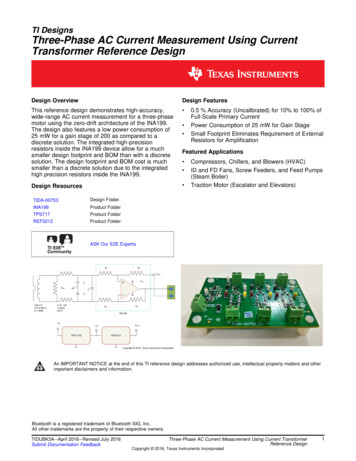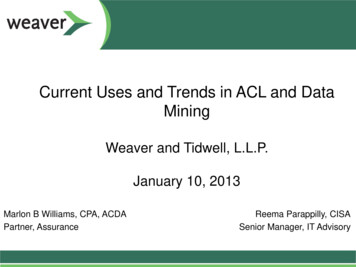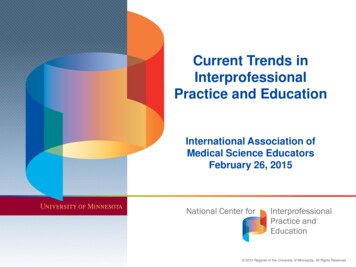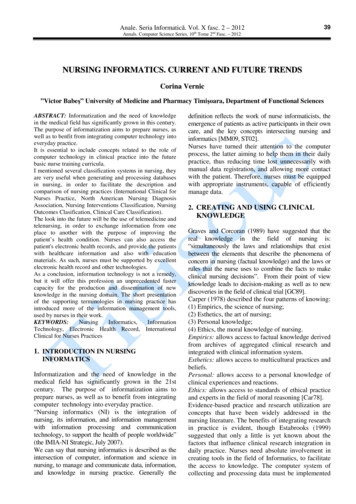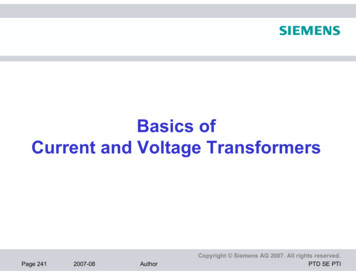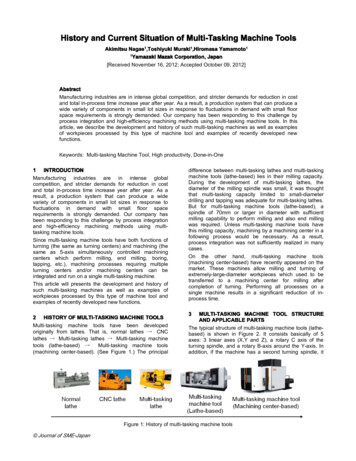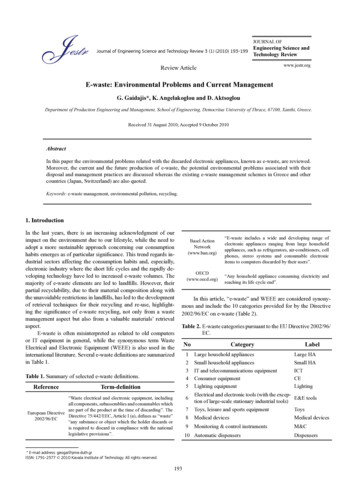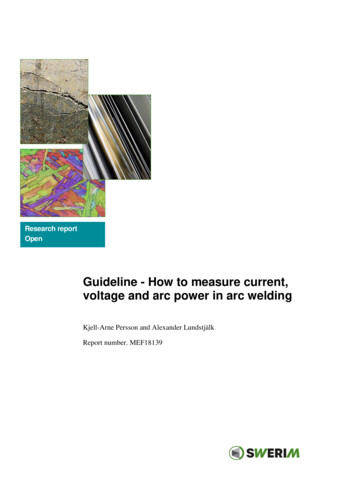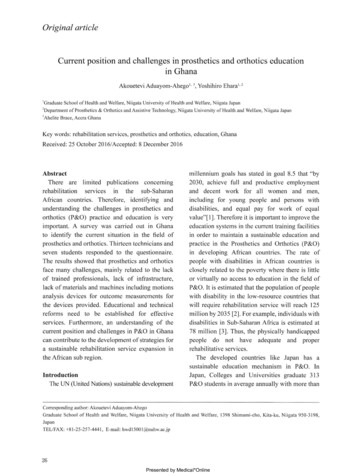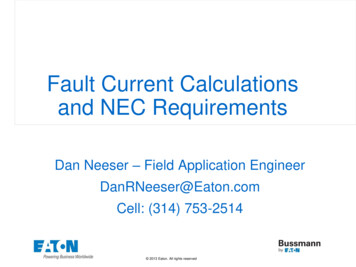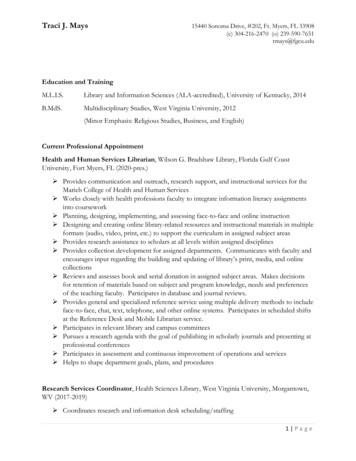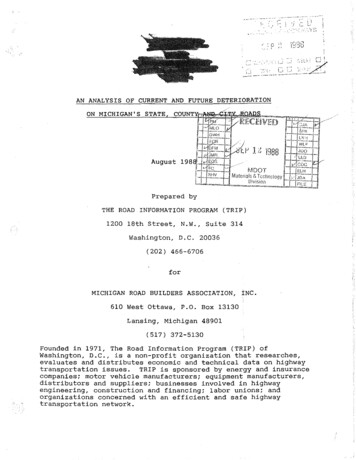
Transcription
·"' ·, -·I:·';'·- ··', ,. '''·c ''· I'! I'i 0J''3GAN ANALYSIS OF CURRENT AND FUTURE DETERIORATIONPrepared byTHE ROAD INFORMATION PROGRAM (TRIP)1200 18th Street, N.W., Suite 314Washington, D.C. 20036(202) 466-6706forMICHIGAN ROAD BUILDERS ASSOCIATION, INC.610 West Ottawa, P.O. Box 13130Lansing, Michigan 48901(517) 372-5130Founded in 1971, The Road Information Program (TRIP) ofWashington, D.C., is a non-profit organization that researches,evaluates and distributes economic and technical data on highwaytransportation issues.TRIP is sponsored by energy and insurancecompanies; motor vehicle manufacturers; equipment manufacturers,distributors and suppliers; businesses involved in highwayengineering, construction and financing; labor unions; andorganizations concerned with an efficient and safe highwaytransportation network.
IntroductionMichigan's 117,803-mile highway system is the .seventhlargest road system in the United States, carrying more than 75billion vehicle miles of travel per year.That traffic continuesto grow -- now increasing by about 3 percent per year -- and isexpected to reach 115 billion vehicle miles a year by the end ofthe century.While growing traffic volumes indicate an active, healthyeconomy, it is important to examine the extent of wear and tearthese greater numbers of vehicles are causing Michigan's roadsystem, much of which has been in place for at least 40 years.This study assesses the extent of road and bridgedeterioration, along with anticipated repair needs over the next12 years, and recommends a program of major improvements to allowMichigan to catch up with existing needs and keep up withcontinuing needs through the year 2000.Sources of information for this study include the MichiganDepartment of Transportation, the Michigan Department ofCommerce, the Federal Highway Administration and other governmentand private agencies.
-3-Driver and Vehicle GrowthThe growth in the number of registered motor vehicles andlicensed drivers in Michigan has been steady over the pastdecade.In 1976, the state registered 5.97 million vehicles and6.05 million motorists.By 1986, the number of vehicleregistrations had climbed 14.4 percent, to 6.83 million, anddrivers' licenses had climbed 4.6 percent, to 6.33 million.Growth in drivers and vehicles would have been greaterexcept for the economic recession of the early 1980s, when manyMichigan residents moved to other states in search of jobs.However, the downward trends have reversed and state plannersanticipate that the numbers will continue to climb steadily intothe next decade.Growth of Travel on Michigan's RoadsThe number of vehicle miles traveled -- or total traffic -on Michigan's roads, streets and highways climbed 23.1 percentbetween 1980 and 1987, from 61.5 billion to 75.7 billion.Growing volumes of traffic from out of state, traveling both toand through Michigan, contributed greatly to this increase.
-5-Studies of pavement life conducted by the Federal HighwayAdministration in 19 states showed that the average road pavementlasts about 16.2 years.During this time, new pavementdeteriorates very gradually (depending on traffic and weatherconditions) from good to fair condition, then falls more rapidlythrough fair into poor and very poor condition.Currently, some 34,163 miles of state, county and municipalroads in Michigan are deficient and in need of majorimprovements.This backlog represents 29 percent of the state's117,803 total road system.In addition, another 52.2 percent of the system -- some61,516 miles -- is expected to deteriorate into substandardcondition over the next 12. years.These 95,679 miles -- 81.2 percent of all roads in Michiganwill need any of several kinds of improvements, including: resurfacingresurfacing and adding new lanesreconstructingreconstructing and adding new lanesintersection improvements
-7-The average lifespan of a bridge is estimated at about 50years, depending on traffic, weather and design.A total of3,465 (32.6 percent) of Michigan's bridges were built at least 50years ago.Currently, the Department of Transportation lists2,026 bridges that are posted for restricted vehicle weights.The Cost of ImprovementsIt would cost a total of 14.4 billion over the next 12years to bring Michigan's substandard roads and bridges up togood condition and to keep up with continuing pavementdeterioration.This figure includes anticipated inflationaryimpact through the next decade.It does not include the cost ofconstructing any new roads and bridges or routine maintenance andadministration.TRIP recommends a 12-year road and bridge capitalimprovement program (running to the year 2000), averaging 1.2billion a year.A 12-year program is recommended because itwould take about that long to schedule the work and generateadequate funding.
-9-In the 12 months from June 1, 1987 through May 31, 1988, theMichigan Transportation Fund received a total of 1.05 billion: 648.4 million from motor-fuel taxes, 31.2 million from dieselvehicle taxes and 340.7 million from vehicle registration fees.The total 1.05 billion represents an increase of 4.8 percentover the previous 12 months, due largely to increasing travel andmotor-fuel purchases.Michigan's diesel fuel tax revenues would be higher if thestate did not have a 6-cents-per-gallon exemption for commercialmotor carriers (with a special permit).The state Department ofTransportation estimates that about 82 percent of all diesel fuelsold is discounted through this program, which generated a lossof more than 13 million to the Michigan Transportation Fund in1986.Michigan's motor-fuel tax was increased from 11 to 13 centsa gallon on January 1, 1983, and another two cents, from 13 tothe current 15 cents a gallon on January 1, 1984.The 2-centincrease each year was the maximum allowable increase based onthe indexing of the motor-fuel tax adjusted for inflation.adjustable tax relies on the Federal Highway AdministrationMaintenance Index as well as the total number of gallons ofmotor-fuel sold each year.This
-11-Federal AidEach time Michigan motorists fill up their gas tanks, theypay a federal motor-fuel tax of 9 cents per gallon, 1 cent ofwhich is dedicated to mass transit purposes.Revenues from theremaining 8 cents go into the Federal Highway Trust Fund which ismanaged by the Federal Highway Administration in Washington, D.C.In 1987, Michigan received 365 million in federal aid forroad and bridge improvements -- 23 million less than in 1986 and 84 million less than in 1985.However, a large chunk of federal-aid funds contributed byMichigan does not return to the state coffers.Despite aCongressionally prescribed formula mandating that at least 85percent of the revenues generated in Michigan be returned toMichigan, this is not happening.Because the Highway Trust Fund is considered part of theunified national budget, it is subject to the same constraints(Gramm-Rudman-Hollings budget controls) as other federaldepartments.Therefore, funds continue to sit frozen in theHighway Trust Fund.
-13-State39.1 percent83 Counties39.1 percent532 Cities & Villages21.8 percentIn fiscal year 1987, these proportions amounted to thefollowing distributions:state highways, 326 million; countyroad commisions, 326 million; and city and village streets, 184million.It is important to note that these distributions coveroperational and maintenance expenses as well as capitalimprovements.Michigan's County Road Association estimated that45 to 50 percent of their revenues pay for activities other thanroad and bridge improvements, including snow removal, mowing,shoulder grading, pavement patching and striping.Local governments also may raise road and bridge improvementfunds through direct taxation, local general fund contributions,special assessments on property and bonding.In addition,legislation passed in December 1987 allows local governments theoption of imposing local vehicle registration fees of up to 25.00.
-15-TRIP's driving cost estimates are based on a CongressionalBudget Office analysis of data compiled by the Office of HighwayPlanning of the Federal Highway Administration and studies byRunzheimer International for the American Automobile Associationon the costs of owning and operating a car.The Economic ImpactMichigan's roads and bridges are the backbone of the state'seconomy.Adequate, well-maintained roads provide dependable andeasy access for businesses -- to bring people to jobs, totransport raw materials to factories and finished goods to market(especially in just-in-time-delivery businesses) and to carry themultitude of service industries so important to Michigan'seconomic health.And clearly, Michigan's economy is thriving.the Michigan Department of Commerce report that,Researchers at"Michigan'srecord-setting performance in construction activity in 1987provides further evidence the state has made a robust andsustained recovery from the 1981-1982 recession."
-17According to the Michigan Travel Bureau, the Wolverine Stateis primarily a regional vacation area, and many 'of its visitorsare from neighboring states -- within an easy day's drive.Infact, an estimated 90 percent of tourists' trips in Michigan areby automobile, compared with 80 percent nationally.In 1987, tourists spent some 8.3 billion on travel-relatedindustries in the state, supporting some 316,000 jobs forMichigan citizens.The Travel Bureau reports that anotherestimated 6.5 billion was spent as part of the "multipliereffect," as tourism dollars move through other parts of theeconomy.But tourists will not continue to travel to vacation spotsthat are difficult, inconvenient or uncomfortable to reach.Traffic congestion and Old, dilapidated roadways can disillusioneven the most ardent visitor, and the lakes, forests and resortsof other Midwestern states will appear more attractive if accessin those states is easier.ConclusionIf Michigan is to provide its citizens with the qualitysurface transportation system on which they have come to rely,solutions must be found for the problems of funding road andbridge improvements in the coming years.
EMBARGOED FOR RELEASE UNTIL9:30A.M., WEDNESDAY, AUGUST 31, 1988FROM:CONTACTS:Ketchum Public Relations142 E. Ontario, 11th FloorChicago, IL 60611William M. Wilkins, TRIP(202) 466-6706FOR:Martha J. Hudak, Ketchum(312) 266-4550The Road Information Program (TRIP)1200 18th Street, NW, Suite 314Washington, DC 20036Cheryl RonkMichigan Road Builders Assn.(517) 372-5130 14.4 BILLION NEEDED THROUGH TURN OF CENTURYFOR MICHIGAN'S ROAD, BRIDGE SYSTEMWashington, DC -- Michigan's roads and bridges will need 1.2 billion worth of repairs and construction annually throughthe year 2000 to catch up with the current backlog and keep pacewith continuing deterioration, according to a study releasedtoday by The Road Information Program (TRIP).The current spending level of 745 million annually wouldneed to increase 61 percent to reach the level of spending TRIPrecommends."The problem has not been ignored by our legislators andGovernor.Several highway funding bills have been passed in thelast five years which demonstrates the commitment Michigan has tomaintain the best roads in the country", said Lawrence W. Martin,executive director of the Michigan Road Builders Association."This additional funding has allowed the state to make manyneeded repairs -- but there is still much more that needs to bedone to keep our existing system from deteriorating further",Martin said.- more -
14.4 BILLION NEEDED UNTIL YEAR 2000The Road Information ProgramAdd 1-1-1The TRIP study found over 81 percent of Michigan's roadsystem either now requires repair or will deteriorate over thenext 12 years.In addition, 23 percent of the state's 10,643bridges will need to be repaired or improved during the sameperiod.Michigan drivers pay an average of 76 more per driver eachyear in increased vehicle operating costs from driving on rough,uneven road surfaces than they would spend driving on roads ingood condition, according to the TRIP study."A slight adjustment in user fees to repair the roads ismore economical for the Michigan motorist than paying five timesas much for auto repairs," Martin said."For example, if the capwas eliminated from the state's gas-tax formula,the averagemotorist would pay only 1.5 more a year, or 4 cents per day."Travel on Michigan's road system increased by more than 23percent between 1980 and 1987 and is expected to grow another 64percent by the year 2000 if travel continues growing at thecurrent rate."Increased tourism in Michigan has contributed to the growthin travel, as evidenced by the record number of travelersanticipated this Labor Day Weekend in Michigan," Martin added."Good roads are vital for building the tourism industry as wellas keeping and attracting more business and industry to ourstate."- more -
14.4 BILLION NEEDED UNTIL YEAR 2000The Road Information ProgramAdd 2-2-2However, highway revenue for Michigan is not keeping pacewith travel growth because of more fuel-efficient vehicles.Theaverage Michigan motorist paid 6 percent less in fuel tax in 1987than he did in 1981. The statemotor fueltax is Michigan'smajor source of income to maintain and build its roads and bridges.In addition, federal aid for highways is declining becausefunds are sitting frozen in the Federal Highway Trust Fund tooffset the national budget deficit.Michigan received 365million in federal aid in 1987 for road and bridge improvements - a decline of 30 percent in two years.A separate TRIP study released last year found that Michiganranked last of six neighboring states in the amount "per capita"it spends for highway improvements on the state system -- 4,176per mile versus the regional average of 6,056 per mile."The state faces a double-edged sword:the costs to repairor replace roads and bridges are climbing, but as repairs aredelayed because of inadequate funds, deterioration occurs morequickly and costs escalate," TRIP concluded.TRIP was commissioned by the Michigan Road BuildersAssociation to compile the study, "An Analysis of Current andFuture Deterioration on Michigan's State, County and City Roads."Sources include the Michigan Department of Transportation, FederalHighway Administration and other government and private agencies.Based in washington, D.C., TRIP was founded in 1971 as anonprofit organization to research, evaluate and distributeeconomic and technical data on highway transportation issues.# # #
Opening StatementLawrence W. MartinExecutive DirectorMichigan Road Builders Associationfor release of theTRIP StudyAugust 31, 1988ASALLROADMICHIGANREPAIRSMOTORISTSWILL NATTEST, NUMEROUS GSTATE.WEEKEND,BEING CTION ZONES IN OPERATION THIS YEAR.MANY OF THESE GAINS HAVE BEEN MADE BY THE COMMITMENTWEHAVEINNETWORK. INFEE GASMICHIGANTOMAINTAININGAGOODROAD1982, THE STATE LEGISLATURE RAISED THE USERTAX TOPROVIDENEEDED FUNDS. THENINTHEMID-80'S, GOVERNOR BLANCHARD AND HIS ADMINISTRATION INSTIGATEDA BONDING PROGRAM WHICH ACCELERATED NEEDED REPAIRS FORCOUNTIESANDCITIESREPLACEMENT PROJECTS.PROVIDEDBEFORETHESEREPAIRSBECAMEIN ADDITION, THE STATE RTATION PACKAGE WHICH WILL PROVIDE 90 MILLION FORNEEDED ROAD IMPROVEMENTS.EVEN THOUGH CONSIDERABLE PROGRESS HAS BEEN MADE THEREISSTILLASSOCIATIONDO.THE(MRBA) RONG
COMMITMENTOURPRESERVETOTRANSPORTATION SYSTEMSURFACEEXISTINGTHE MAJOR ARTERIES ARE IN PLACEBUT WE MUST MAINTAIN THEMTHE ROAD INFORMATION PROGRAM (TRIP) HAS JUST COMPLETEDA STUDYON WHAT MICHIGAN WOULD NEED TO DO TO BRINGOUR WHOLE SYSTEM UP TO STANDARD BY THE YEAR 2000.MICHIGAN'S ROADS AND BRIDGES ARE REACHING SENIOR CITIZENSTATUS.LIFEMANYOF OADSBRIDGES--50THROUGHOUTTIMEFRAME.WERE BUlL T TO HAVEYEARS.THEMOSTSTATEOFAOURHAVEEASILYTRIPNOTES,IN ADDITION, ASTRAVEL ON MICHIGAN'S HIGHWAYS, COUNTY ROADS AND MUNICIPALSTREETS HAS INCREASED 23% IN THE PAST SEVEN YEARS AND ISEXPECTED TO CONTINUE TO DBRIDGE SITUATION IN THE STATE AS WELL AS WHAT FUNDS ARECURRENTLY BEING ALLOCATED TO THESE NEEDS. THE OMMENDINGARESULTS OF THE 1987 TRANSPORTATION PACKAGE.THEBOTTOMLINEISTHATTRIPISPROGRAM OF AN ADDITIONAL 455 MILLION ANNUALLY FOR THENEXT 12 T MEPOSSIBLE FUNDING SOURCESTO
ELIMINATE THIS SHORTFALL.BY ELIMINATING THE DIESEL FUEL EXEMPTION IN MICHIGAN WEWOULD SEE AN ADDITION 13 MILLION.THE STATE'S DIESEL FUELDISCOUNT IS CURRENTLY 6 CENTS PER GALLON. THIS CHART PRODUCEDBY THE MICHIGAN DEPARTMENT OF TRANSPORTATION DEMONSTRATESTHAT MICHIGAN HAS ONE OF THE LOWEST DIESEL FUEL TAX RATES INTHE NATION.IF THE CURRENT STATE GAS TAX CAP WAS ELIMINATED, WHICHISCURRENTLYAT15 PERGALLONANDTHEALLOWED TO WORK AS ORIGINALLY PLANNED,THATTHESTATEADDITIONAL 2 PERGASTAXGALLONWOULDFORMULAMRBA ESTIMATESINCREASEAND GENERATEWAS 90ONLYMILLION.ANTHIS,ACCORDING TO TRIP, WOULD COST THE AVERAGE MOTORIST ONLY 15 A YEAR Or 4 A DAY.ANOTHERAREA OF FUNDING IS TO RESTORE FEDERAL AID TO THE1985 LEVEL.TOTHIS WOULD PROVIDE AN ADDITIONAL 100 ASTTHISCHARTTHREEYEARS.HOW MUCHWITHTHEHIGHWAY TRUST FUND BEING PART OF THE UNIFIED NATIONALBUDGET,ITHASBEENSUBJECTTOTHEGRAMM- RUDMAN-HOLLINGS BUDGET CONTROLS. AS A RESULT, THE HIGHWAY TRUSTFUND BALANCE CONTINUES TO GROW.BILLION.STATESTHIS YEAR IT REACHED 10IF THESE FUNDS COULD BE ALLOCATED BACK TO THEINSTEADOFBEINGHELDHOSTAGE,NEEDEDREPAIRS
COULD BE DONE IN A TIMELY FASHION.THROUGHTHESETHREEMETHODSALONE,MICHIGAN WOULDACHIEVE ABOUT HALF OF WHAT TRIP RECOMMENDS.ADDITIONALREVENUES WOULD NEED TO BE RAISED FROM LOCAL UNITS EDROAD MILLAGESORPROPERTYTAXES,BONDING PROGRAMS.EACH UNIT OF GOVERNMENT NEEDS TO EVALUATE WHAT IT CAN DOTO GENERATE THESE FUNDS.AS THE STUDY NOTES, MORE NEEDSTO BE DONE AT ALL LEVELS OF GOVERNMENT.MOTORISTS THROUGHOUT THE STATE, IN OUR OPINION, WOULDPREFER TOROADPAYAFEW EFORMONEYTOREPLACING SHOCKS, TIRES AND OTHER PARTS OF THEIR VEHICLESBECAUSE OF POOR ROADS.AS WAS RECENTLY NOTED IN A NATIONAL REPORTBEYOND THEGRID LOCK: THE FUTURE OF MOBILITY AS THE PUBLIC SEES ION'S '2020' HEARINGS), CONGESTION IN URBAN AREASIS LIKELY TO INCREASE AND THE ROAD FACILITIES WILL NOTBE IN PLACE IN ORDER TO HANDLE THIS TRAFFIC.TO MAINTAIN AND CONTINUE THE GROWTH THAT MICHIGAN DUSTRY,CHANGEININ"JUSTECONOMICINTIME"
THEWITHTHEGOVERNOR,THELEGISLATURE AND THE DEPARTMENT OF TRANSPORTATION, WE CANDEVELOP AND FUND A PROGRAM THAT WILL PROVIDE FOR THENEXT GENERATION THE SAME FREI':DOM OF MOBILITY WE HAVEENJOYED.
Runzheimer International for the American Automobile Association on the costs of owning and operating a car. The Economic Impact Michigan's roads and bridges are the backbone of the state's economy. Adequate, well-maintained ro
